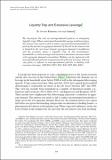Liquidity Trap and Excessive Leverage
Author(s)
Korinek, Anton; Simsek, Alp
DownloadSimsek_Liquidity trap.pdf (733.7Kb)
PUBLISHER_POLICY
Publisher Policy
Article is made available in accordance with the publisher's policy and may be subject to US copyright law. Please refer to the publisher's site for terms of use.
Terms of use
Metadata
Show full item recordAbstract
We investigate the role of macroprudential policies in mitigating liquidity traps. When constrained households engage in deleveraging, the interest rate needs to fall to induce unconstrained households to pick up the decline in aggregate demand. If the fall in the interest rate is limited by the zero lower bound, aggregate demand is insufficient and the economy enters a liquidity trap. In this environment, households' ex ante leverage and insurance decisions are associated with aggregate demand externalities. Welfare can be improved with macroprudential policies targeted toward reducing leverage. Interest rate policy is inferior to macroprudential policies in dealing with excessive leverage.
Date issued
2016-03Department
Massachusetts Institute of Technology. Department of EconomicsJournal
American Economic Review
Publisher
American Economic Association (AEA)
Citation
Korinek, Anton, and Alp Simsek. “ Liquidity Trap and Excessive Leverage † .” American Economic Review 106, no. 3 (March 2016): 699–738. © 2016 American Economic Association.
Version: Final published version
ISSN
0002-8282